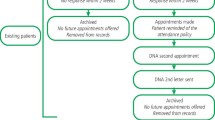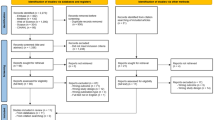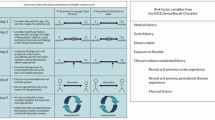Abstract
Aim It is the aim of this paper to consider whether overall patient treatment history per se and what length of patient history, matters in predicting future treatment need.
Methods This study used a data set (SN7024, available from UKDataService), consisting of treatment records for General Dental Services' (GDS) patients, this being obtained from all items of service payment records for patients treated in the GDS of England and Wales between 1990 and 2006. For the purpose of this study, the GDS dataset for patients attending in 2003 was restricted to adult patients (aged 18 or over on 31 December 1990; that is, year of birth earlier than 1973) who attended in both two-year periods 1991/2 and 2004/5. Each course of treatment was classified as 'active' (eg restoration, extraction, prosthesis) or 'not active' (eg prevention, diagnosis). Treatment costs for 2001-2005 (outcome), 2000 (one-year history), 1999-2000 (two-year history) and so on until 1991-2000 (ten-year history) were determined, and history and outcome correlated.
Results A total of 455,844 patients met the inclusion criteria, namely adults with a full history. They received 9,341,583 courses of treatment, of which 49% were classified as 'active' and 51% as 'not active'. The analysis indicated that both total costs and active treatment costs are positively correlated with their historical values, with the correlation coefficients increasing from 0.24 and 0.25 with one year of history to 0.42 and 0.44 with ten years of history. Overall, therefore, future treatment cost is correlated with past treatment costs.
Conclusions Treatment history may provide an important correlate of future dental treatment needs and the more history the better, at least up to five years. However, active treatment is the important component and should be distinguished from preventive and diagnostic treatments.
This is a preview of subscription content, access via your institution
Access options
Subscribe to this journal
Receive 24 print issues and online access
$259.00 per year
only $10.79 per issue
Buy this article
- Purchase on Springer Link
- Instant access to full article PDF
Prices may be subject to local taxes which are calculated during checkout








Similar content being viewed by others
References
Worthington H V, Holloway P J, Clarkson J E, Davies R M. Predicting which adult patients will need treatment over the next year. Community Dent Oral Epidemiol 1997; 25: 273-277.
Bibby B G, Shern R J (eds) Methods of Caries Prediction. A special supplement of Microbiology Abstracts - Bacteriology. Washington D.C.: IRL Press, 1978.
Abernathy J R, Graves R C, Bohannan H M, Stamin J A, Greenberg B G, Disney J A. Development and application of a prediction model for dental caries. Community Dent Oral Epidemiol 1987; 15: 24-28.
Fonzar F, Fonzar A, Buttolo P, Worthington H V, Esposito M. The prognosis of root canal therapy: a 10-year retrospective cohort study on 411 patients with 1175 endodontically treated teeth. Eur J Oral Implantol 2009; 2: 201-208.
Nagasiri R, Chitmongkolsuk S. The influence of coronal restoration type on survival of endodontically treated teeth. Eur J Prosthodont Rest Dent 2004; 12: 171-176.
Kim S. Prevalence of apical periodontitis of root-canal treated teeth and retrospective evaluation of symptom-related prognostic factors in an urban South Korean population. Oral Surg Oral Med Oral Pathol Oral Radiol Oral Endod 2010; 110: 795-799.
Setzer F C, Boyer K R, Jeppson J R, Karabucak B, Kim S. Long-term prognosis of endodontically treated teeth: a retrospective analysis of preoperative factors in molars. J.Endod 2011; 37: 21-25.
Alomari Q D, Khalaf M E, Al-Shawaf N M. Relative contribution of restorative treatment to tooth extraction in a teaching institution. J.Oral Rehabil 2013; 40: 464-471.
Rinke S, Lange K, Roediger M, Gersdorff N. Risk factors for technical and biological complications with zirconia single crowns. Clin Oral Investig 2015; 19: 1999-2006.
Scotti N, Eruli C, Comba A et al. Longevity of class 2 direct restorations in root-filled teeth: A retrospective clinical study. J.Dent 2015; 43: 499-505.
Ng M C, Ong M M, Lim M P, Koh C G, Chan Y H. Tooth loss in compliant and non-compliant periodontally treated patients: 7 years after active periodontal therapy. J.Clin.Periodontol 2011; 38: 499-508.
Graetz C, Schutzhold S, Plaumann A et al. Prognostic factors for the loss of molars - an 18-years retrospective cohort study. J Clin Periodontol 2015; 42: 943-950.
Danniewitz B, Zeidler A, Husing J et al. Loss of molars in periodontally treated patients: results from 10 years and more after active periodontal therapy. J Clin Periodontol 2016; 43: 53-62.
Pretzl B, Eickholz P, Saure D, Pfefferle T, Zeidler A, Danniewitz B. Endodontic status and retention of molars in endodontically treated patients: results after 10 years or more of supportive periodontal therapy. J Clin Periodontol 2016; 43: 1116-1123.
Nibali L, Sun C, Akcali A, Meng X, Tu Y K, Donod N. A retrospective study on periodontal disease progression in private practice. J Clin Periodontol 2017; 44: 290-297.
Information Centre for Health and Social Care, NHS Business Services Authority. Longitudinal Dental Treatment, 1990-2006. 2012; DOI: 10.5255/UKDA-SN-7024-1.
Elderton R J, Nuttall N M. Variation among dentists in planning treatment. Br Dent J 1983; 154: 201-205.
Burke F J T, Lucarotti P S K. The ultimate guide to restoration longevity in England and Wales. Part 4: resin composite restorations: time to next intervention and to extraction of the restored tooth. Br Dent J 2018; 224: 945-956.
Burke F J T, Lucarotti P S K. The ultimate guide to restoration longevity in England and Wales. Part 5: crowns: time to next intervention and to extraction of the restored tooth. Br Dent J 2018;.225: 33-48.
Burke F J T, Lucarotti P S K. The ultimate guide to restoration longevity in England and Wales. Part 10: key findings from a ten million restoration dataset. Br Dent J 2018; 225: 1011-1018.
Acknowledgements
The authors acknowledge the support of the Economic and Social Data Service, the Health and Social Care Information Centre and the NHS Business Services Authority for collating and releasing this valuable data resource.
Author information
Authors and Affiliations
Corresponding author
Rights and permissions
About this article
Cite this article
Lucarotti, P., Burke, F. Patient history as a predictor of future treatment need? Considerations from a dataset containing over nine million courses of treatment. Br Dent J 228, 345–350 (2020). https://doi.org/10.1038/s41415-020-1305-4
Published:
Issue Date:
DOI: https://doi.org/10.1038/s41415-020-1305-4



